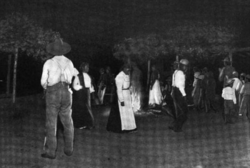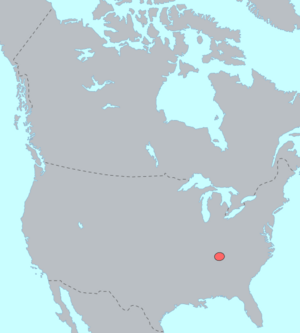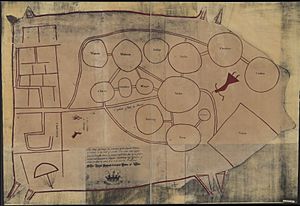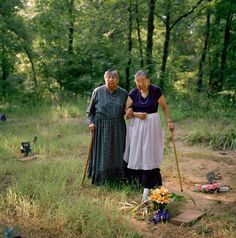Yuchi facts for kids
|
Yuchi people dancing
the Big Turtle dance, 1909 |
|
| Total population | |
|---|---|
| 2010: 623 | |
| Regions with significant populations | |
Today: Oklahoma Historically: Tennessee, later Alabama and Georgia |
|
| Languages | |
| English, Yuchi | |
| Religion | |
| Christianity (Methodist), Stomp Dance, Native American Church |
|
| Related ethnic groups | |
| Muscogee people |
The Yuchi people, also called Euchee or Uchee, are a Native American group. They are mostly based in Oklahoma today.
In the 1500s, the Yuchi lived in the eastern Tennessee River valley. By the late 1600s, they moved south to Alabama, Georgia, and South Carolina. They settled near the Muscogee Creek people. Some Yuchi also moved to Florida.
During the 1700s, many Yuchi people died from diseases and wars. In the 1830s, the US government forced the remaining Yuchi to move to Indian Territory (now Oklahoma). They moved along with their allies, the Muscogee Creek.
Today, most Yuchi live in northeastern Oklahoma. Many are officially part of the Muscogee (Creek) Nation. They still keep their unique culture alive. Some Yuchi people also speak the Yuchi language, which is a special language not related to any other.
Contents
Understanding the Yuchi Name
The name Yuchi means "over there sit/live" or "situated yonder." The Yuchi people call themselves Tsoyaha or Coyaha. This name means "Children of the Sun."
Their language is unique and not connected to other languages. The Shawnee people called them Tahokale. The Cherokee people called them Aniyutsi.
Yuchi History and Early Life
When Europeans first arrived, the Yuchi lived in what is now eastern Tennessee. In 1541, the Spanish explorer Hernando de Soto described them. He called them a strong tribe known as the Uchi. They were also linked to the Chisca tribe.
Historians and archaeologists have found proof of several Yuchi towns from the 1700s. One town was Chestowee in present-day Bradley County, Tennessee. In 1714, the Cherokee attacked and destroyed Chestowee. This attack was encouraged by English fur traders from South Carolina. The Cherokee wanted to attack more Yuchi towns, but the South Carolina government stopped them. The destruction of Chestowee showed that the Cherokee were becoming a major power in the Southeast.
Later, Yuchi towns were found in northern Georgia and western South Carolina. The tribe had moved there to avoid pressure from the Cherokee. One town, "Mount Pleasant," was on the Savannah River in Effingham County, Georgia. It existed from about 1722 to 1750. The British built a trading post and a small fort there to trade with the Yuchi.
"Euchee Town" was a large settlement on the Chattahoochee River. It was active from the mid to late 1700s. It was near Euchee Creek, about ten miles downriver from the Muscogee Creek town of Coweta. The scientist William Bartram visited Euchee Town in 1778. He wrote that it was the biggest and most organized Native American town he had seen. Its houses were large and well-built.
US Indian agent Benjamin Hawkins also visited Euchee Town. He said the Yuchi were "more orderly and industrious" than other tribes in the Muscogee Creek Confederacy. Some Yuchi then started to move into the Florida panhandle.

In the late 1700s, English colonists noted Patsiliga, a Yuchi settlement on the Flint River. Other Yuchi villages were on the Oconee River and Brier Creek in Georgia. A Yuchi town also existed from 1746 to 1751 at Silver Bluff, Georgia in Aiken County, South Carolina.
During the 1700s, the Yuchi made friends with white settlers in the Southern Colonies. They traded deerskins and sometimes even people with them. The Yuchi population dropped sharply in the 1700s. This was due to diseases from Europe, which they had no protection against. Wars with the Cherokee, who were moving into Yuchi land, also caused many deaths.
After the American Revolution, the Yuchi stayed close to the Muscogee Creek Confederacy. Later, many Yuchi became official members of the Muscogee Nation. Some Yuchi moved south to Florida with the Muscogee. There, they became part of the new Seminole people.
During the Creek War of 1813–1814, many Yuchi joined the Red Sticks. These were traditional Muscogee who did not like European-American culture. Euchee Town became less important. The Yuchi tribe became one of the poorest Muscogee communities. The old town site is now a National Historic Landmark within Fort Benning, Georgia.
In the 1830s, the US government forced the Yuchi and Muscogee to move. They were moved from Alabama and Georgia to Indian Territory (now Oklahoma). The Yuchi settled in the northern and northwestern parts of the Muscogee Nation. Three Yuchi towns they built there in the 1800s still exist today: Duck Creek, Polecat, and Sand Creek.
Yuchi in the Second Seminole War
Before 1818, some Yuchi moved near Lake Miccosukee in northern Florida. They settled near Muscogee refugees. Andrew Jackson's invasion of the area during the First Seminole War made the Yuchi move to eastern Florida.
They fought with the Seminole during the Second Seminole War. Their chief was Uchee Billy. In 1837, General Joseph Marion Hernandez captured Uchee Billy and his brother Jack. The general also captured Osceola. The two Yuchi leaders were held in Fort Marion in St. Augustine, Florida for years.
From 1890 to 1895, the Dawes Commission saw the Yuchi in Indian Territory as an independent tribe. They registered tribal members to divide communal land among individual families. About 1200 Yuchi members were registered. However, the Dawes Commission later decided to group the Yuchi with the Muscogee (Creek) Nation. This was to make land division simpler. But this decision stopped the Yuchi from being recognized as an independent tribe.
Current Status of the Yuchi People
Many Yuchi people are part of federally recognized tribes. Most are enrolled in the Muscogee (Creek) Nation. The Muscogee Nation helps with the Euchee Language Program. In the 1990s, the Yuchi Tribal Organization in Sapulpa, Oklahoma, asked the US government to recognize them as an independent tribe. In 2000, the Bureau of Indian Affairs said no to their request.
In 1997, the Yuchi tribe had 249 official members. Other Yuchi descendants are members of different tribes, like the Muscogee or Shawnee. Most Yuchi people have family from several different tribes.
The Euchee Tribe of Indians is not federally recognized, but they have their main office in Sapulpa, Oklahoma. Their co-chairmen are Felix Brown Jr. and Clinton Sago.
James Anaya, a United Nations (UN) expert on Indigenous Peoples' Rights, visited the Yuchi community. Tracie Revis (Yuchi) spoke about how important federal recognition is. He mentioned the UN's declaration that says Indigenous Peoples have the right to decide their own future. This includes their political status and their economic, social, and cultural growth.
About 2,000 people today are ethnically Yuchi. They are descendants of about 1,100 people recorded in 1950. This record was made when the Indian Claims Commission was settling land claims.
The Yuchi still hold important ceremonies, like the Green Corn Ceremony in late summer. They have three special ceremonial grounds in Oklahoma. Some Yuchi are part of the Native American Church or Methodist churches.
In 2008, the Yuchi tribe received a grant from President George W. Bush. This grant was for a community survey and plan for Native Americans. They used it to start the Tribal History Project in October 2010.
The Human Genome Project recognized the Yuchi's unique culture and language. They asked the Yuchi to provide genetic data (DNA). The Yuchi tribe said no. They did not want to participate because of cultural reasons and concerns about the government owning their tribal DNA.
The Yuchi Language
The Yuchi language is a linguistic isolate. This means it is not known to be related to any other language in the world. In 2000, there were about 15 fluent Yuchi speakers. By 2006, this number dropped to 7. A 2011 documentary said there were only five first-language speakers left.
However, young Yuchi people have been learning the language in recent years. Yuchi language classes are taught in Sapulpa, Oklahoma. This effort is led by Richard Grounds and the Euchee Language Project. In 2011, the Administration for Native Americans gave the Yuchi tribe a grant. This grant helps fund after-school programs for youth. The goal is to improve their native language skills and create a new generation of speakers.
The Yuchi people and their language are featured in a book called Spoken Here: Travels Among Threatened Languages by Mark Abley. This book is about endangered languages.
Notable Yuchi People
- Uchee Billy (died 1837), a brave warrior and chief
- Sam Story, a chief in the 1800s
- Richard Ray Whitman (born 1949), an artist, poet, and actor
Images for kids
See also
 In Spanish: Yuchi para niños
In Spanish: Yuchi para niños






